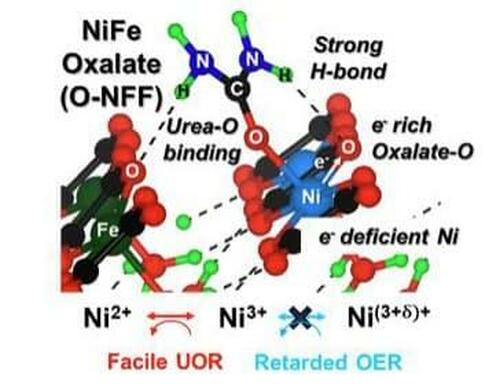By Brian Westenhaus of OilPrice.com
Pohang University of Science & Technology scientists have developed a catalyst for the urea oxidation reaction, enhancing hydrogen generation efficiency. Professor Kangwoo Cho and PhD candidate Jiseon Kim from the Division of Environmental Science & Engineering at Pohang University (POSTECH) collaborated with the Korea Institute of Science and Technology (KIST) to devise a novel catalyst aimed at enhancing the efficiency of reactions using contaminated municipal sewage to produce hydrogen — a noteworthy green energy source.
The research has been recently featured in the international journal Advanced Functional Materials.
Schematic Depicting the catalytic reaction devised by the team that catalyzes the urea oxidation reaction to assist the water electrolysis reaction. Image Credit: Pohang University of Science & Technology. For more images click the press release link here. For a bit more info try the abstract or purchase the study paper.
With the growing environmental concerns of pollution associated with fossil fuel, hydrogen has garnered increased interest. Water electrolysis technology is a known sustainable process that leverages Earth’s abundant water to produce hydrogen.
However, the concurrent oxygen evolution reaction during hydrogen production is notably slow, resulting in a considerably low energy conversion efficiency.
But lately, the academic community has been tackling this issue by integrating the urea oxidation reaction with the hydrogen generation reaction.
Urea, is a pollutant found in urine, that releases a significant amount of energy during its oxidation process, offering a potential means to enhance both the efficiency of hydrogen generation and the purification of toilet wastewater.
That made it necessary to find a catalyst that can effectively drive the urea oxidation reaction, thereby amplifying the efficiency of both hydrogen generation and wastewater treatment.
In pursuit of increased efficiency in the urea oxidation reaction, the team created a catalyst known as nickel-iron-oxalate (O-NFF). This catalyst combines iron (Fe) and oxalate on nickel (Ni) metal, resulting in an expansive surface area characterized by nanometer-sized particles in fragment form.
This unique property enables the catalyst to adsorb more reactants, facilitating an accelerated urea oxidation reaction.
In experiments, the O-NFF catalyst devised by the team successfully lowered the voltage required for hydrogen generation to 1.47 V RHE (at 0.5 A/cm2) (Reversible Hydrogen Electrode refers to a standard hydrogen electrode, representing a potential of 0V in the standard state—an equilibrium between hydrogen gas and liquid hydrogen) and exhibited a high reaction rate even when tested in a mixed solution of potassium hydroxide (1 M) and urea (0.33 M) with a Tafel slope of 12.1 mV/dec (The rate of electrochemical reaction; a lower value indicates greater catalyst activity).
The researchers further validated the catalyst’s efficacy by confirming its promotion of the urea oxidation reaction through photoelectron/X-ray absorption spectroscopy using a radiation photo accelerator.
Professor Kangwoo Cho who led the research commented, “We have developed a catalyst capable of purifying municipal sewage while simultaneously enhancing the efficiency of hydrogen production, a green energy source.”
He added, “We anticipate that O-NFF catalysts, synthesized from metals and organics, will contribute to the improved efficiency of industrial electrolysis hydrogen production.”
The research was sponsored by the Mid-Career Researcher Program and the Hydrogen Source Technology Development Program of the National Research Foundation of Korea, and the National Supercomputing Center.
* * *
This is very interesting indeed. The catalyst would offer another revenue stream from treating sewage by yielding a commercial product. There is also the water reduction effect, the hydrogen out the oxygen freed cuts down on the total volume.
The rest of the sewage stream is rich in potassium and phosphorus. Two very important food production fertilizers that are getting increasingly expensive to agriculture.
Then there is the paper-based wood pulp that could be recycled.
The catch in all this is the bacterial and viral loads plus the food particles coming along with the water and those useful chemicals.
Its important to keep working at getting these elements in an economically self-supporting total recycling system. We’re not there quite yet. But it’s a very worthy goal that deserves a continuous push until the profits in sewage can return to the economy.
